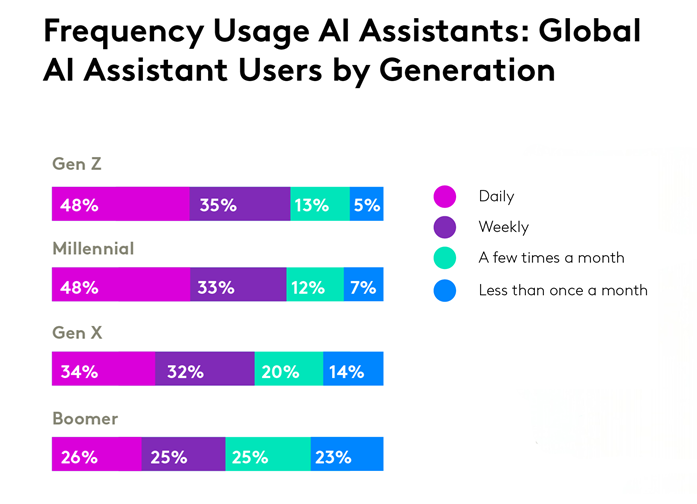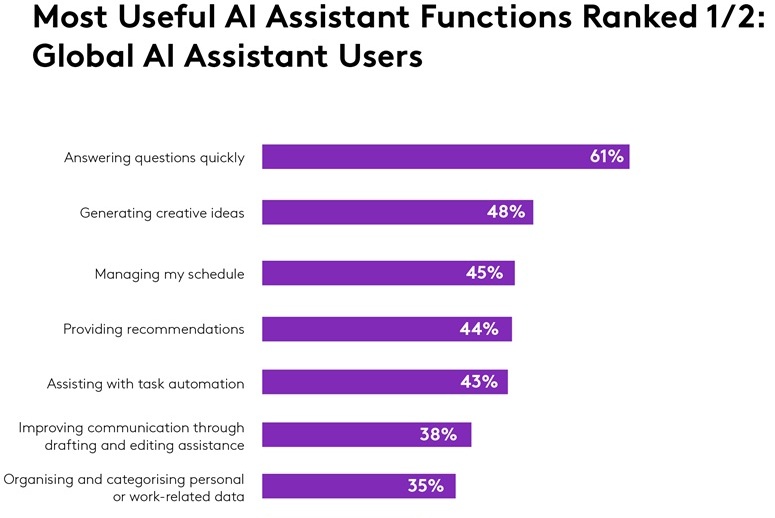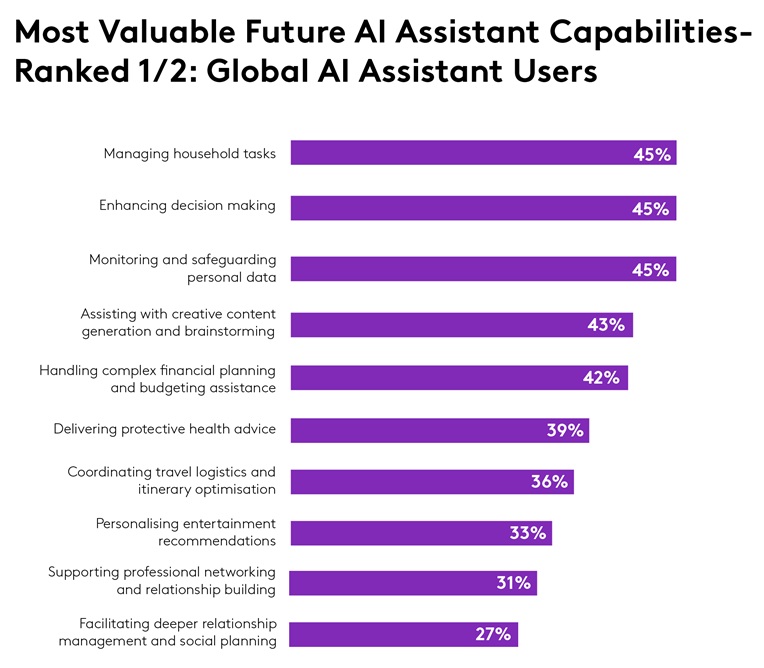Virtual assistants have become a go-to resource for consumers looking to quickly answer questions, shop online, or manage everyday tasks. But as artificial intelligence becomes more sophisticated, these tools are evolving into something far more powerful. Today’s AI assistants are better at understanding context, automating tasks, and delivering personalised recommendations. Whether it’s helping a shopper find the perfect product, coming up with creative ideas, or managing schedules, AI-powered assistants are becoming indispensable companions in the digital lives of consumers around the world.
In a report from the Profiles team at Kantar, Connecting with the AI Consumer, new findings reveal how consumers across ten countries are using AI-powered tools and what this shift could mean for brands hoping to connect with them. The study draws from over 10,000 respondents and explores usage, consumer priorities, and regional differences in AI adoption.
For the purpose of this article, when we refer to “AI assistants,” we’re talking about any AI-based tool that responds to user inputs, automates tasks, or provides recommendations or information. This includes voice assistants, chatbots, virtual assistants, and AI shopping tools. “AI assistant users” are defined as those who have used one or more of these tools in the past few months. Gen Z is identified as ages 18-27, Millennials ages 28-43, Gen X ages 44-59, and Boomers ages 60+.
The growing appeal of AI assistants
As digital experiences become more personalised and efficient, consumers are increasingly turning to AI assistants to help manage their daily lives.
Among those who have ever used an AI tool, 81% report using a voice assistant, chatbot, or shopping assistant in just the last few months. And it’s not just occasional usage—about three in four (76%) say they use these tools for tasks on a weekly or daily basis. Only 24% report less frequent use.
Usage is highest among Gen Z (83%) and Millennials (81%). Gen X sees a moderate level of use at 66%, while only about half (51%) of Boomers report using AI assistants weekly or daily. These patterns suggest that AI is particularly embedded in the routines of younger consumers, many of whom have grown up with digital tools as part of everyday life.

Regional differences also stand out. In India, 67% of respondents say they use AI assistants daily, followed by 50% in China and 46% in Brazil. By contrast, usage is significantly lower in parts of Europe.
In France, 18% of respondents say they use AI assistants less often than once a month, and in Germany, that figure is 14%. These disparities likely reflect a mix of factors from infrastructure and digital maturity to privacy concerns and cultural attitudes toward technology.
What users value most: Speed, creativity, and time-saving support
When asked what they value most in AI assistants, users are clear: speed is the top priority. Sixty-one percent say the most useful feature is the ability to answer questions quickly. That makes sense. Instead of opening a browser and typing out a search, you can just ask a question out loud and get an immediate answer. It reduces friction and makes everyday tasks simpler.

Generating creative ideas is ranked as the second most valued function. This suggests users are seeing AI as more than a functional tool but as a partner in ideation, brainstorming, and content creation. From coming up with recipe ideas to drafting emails or designing travel itineraries, people are tapping into AI’s ability to support creative thinking.
Consumers value AI that helps them save time and think more creatively. Tools that are fast, frictionless, and inspiring are resonating most. Whether you’re building a digital assistant for a retail experience or integrating AI into your app or website, keep the focus on making interactions feel useful and efficient.
What do consumers want next from AI assistants?
Users are ready for AI that’s more integrated, trustworthy, and genuinely helpful in navigating daily life.
And as AI assistants become more common, users are looking beyond simple tasks. They want tools that can help them enhance decision making (45%), help with financial planning or budgeting (42%), optimise travel logistics and itineraries (36%), and personalise entertainment recommendations (33%).

Interestingly, the least appealing capabilities were those related to interpersonal support—things like helping with relationships or networking. This suggests that while consumers are open to using AI for practical and logistical help, there’s still hesitation about relying on it for emotional or social tasks. It reinforces the idea that users see AI as a helpful assistant, not as a replacement for human-centered interactions.
When analysing this data across different ages groups, Boomers, in particular, place strong emphasis on data protection. Fifty-four percent say they’d value tools that monitor or safeguard their information. Meanwhile, younger users are more interested in creative content generation and decision-making support. For example, 48% of Gen Z respondents say they want AI to help them make better decisions, and 46% are drawn to its creative potential.
Brands should consider clearly communicating how personal data is used and give users control over their settings. Transparency and privacy are central to user trust and long-term adoption.
Additionally, tailoring experiences by generation may also be key. While younger users may lean toward AI that boosts productivity and creativity, older consumers may place more value on features that protect their privacy and simplify life management. Understanding your audience’s needs will be critical when designing or refining AI-driven features.
What this means for brands
AI assistants have become widely used and deeply integrated into the digital routines of millions of consumers around the world. People want assistants that are fast, smart, and helpful—but also respectful of their data and needs.
For brands, consider the following:
- Invest in AI tools that feel seamless and human-centered. Focus on features that make everyday life easier (especially around information access, creativity, and organisation).
- Build with trust in mind. Consumers are wary of handing over too much personal data without clear boundaries. Transparency, security, and choice should be baked into every AI interaction.
- Don’t ignore cultural and generational context. Adoption patterns and priorities vary by region and age group. A successful AI experience in India may not translate the same way in France. And what matters to Gen Z likely isn’t top of mind for Boomers.
Ultimately, AI assistants aren’t just a novelty anymore. They’re part of the way people live, think, and interact with brands. Companies that understand this and design with it in mind will be better positioned to earn trust, loyalty, and long-term value from their customers.
Get more answers
For more findings from this study, access the complete Connecting with the AI Consumer report. Here you’ll find additional insights into how global consumers are turning to AI, the trade-offs they’re willing to make, and what they expect in the future.
About this study
This research was conducted online among more than 10,000 consumers across ten global markets (including Australia, Brazil, China, France, Germany, India, Singapore, South Africa, the UK, and the US between April 11th through May 2nd, 2025. All interviews were conducted as online self-completion and collected based on controlled quotas evenly distributed between generations and gender by country. Respondents were sourced from the Kantar Profiles Respondent Hub.






